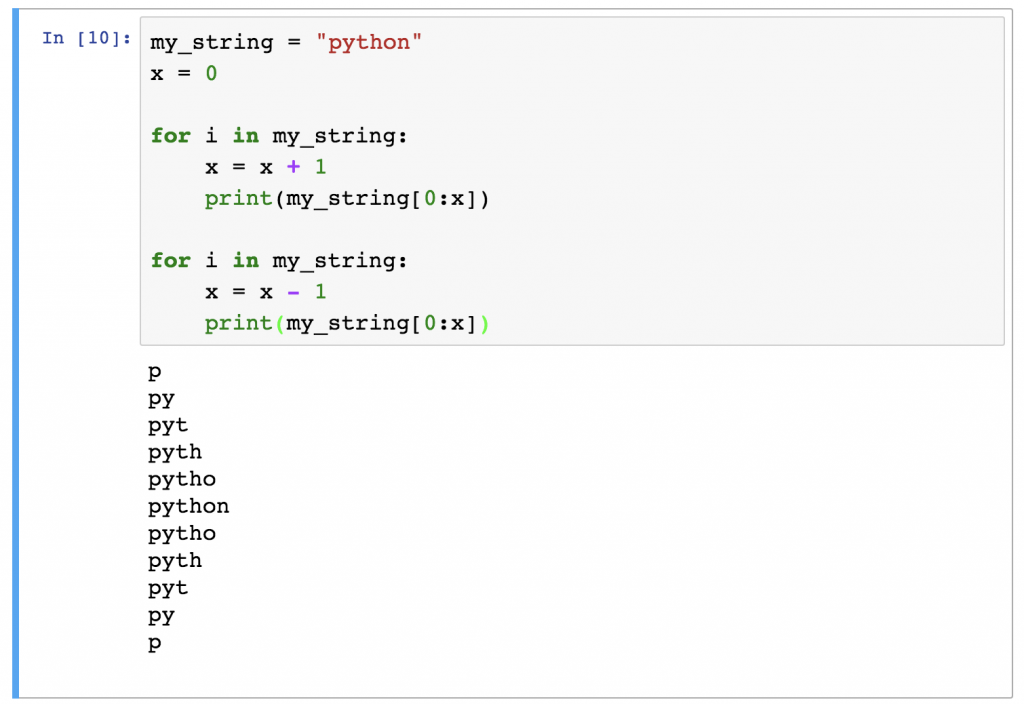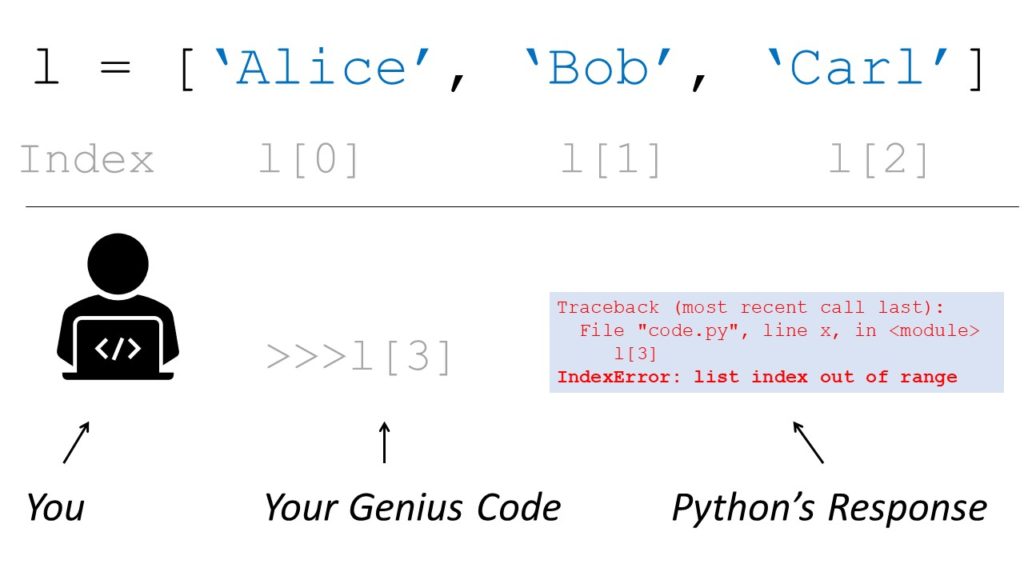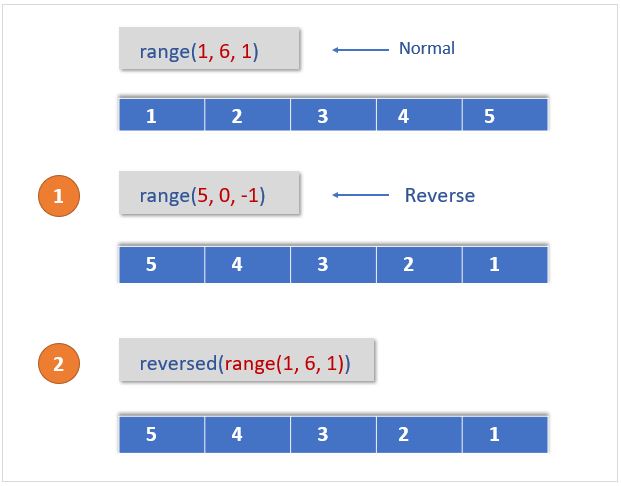Range is a built-in function of Python. 1 3 5 7 9.
 Python For Loops Explained Python For Data Science Basics 5
Python For Loops Explained Python For Data Science Basics 5
Well in Python 2x range produced a list and xrange returned an iterator - a sequence object.

What does for x in range mean in python. Typically it would look like this. The range function is used to generate a sequence of numbers. Difference between Python xrange and range.
The mean method is useful to calculate the meanaverage of the given list of numbers. The range function returns a sequence of numbers starting from 0 by default and increments by 1 by default and stops before a specified number. For i in range0 5.
But you iterate over all indices up to lenl-1 6-1 5 and the index 5 does not exist in the list after removing elements in a previous iteration. In Python Using a for loop with range we can repeat an action a specific number of times. Ifnumber 2 0.
The built-in range function in Python is very useful to generate sequences of numbers in the form of a list. Start is what integer youd like to start your list with stop is what integer youd like your list to stop at and step is what your list elements will increment by. All subsequent elements now have a smaller index.
L x for x in l if x. Mean function can be used to calculate meanaverage of a given list of numbers. This is a function that is present in Python 2x however it was renamed to range in Python 3x and the original range function was deprecated in Python 3x.
Range and xrange are two functions that could be used to iterate a certain number of times in for loops in Python. The arithmetic mean is the sum of data divided by the number of data-points. In Python 2 the range returns a list which is not very efficient to handle large data.
In Python its possible to use _ multiple times in the same expression too. If we have a sample of numeric values then its mean or the average is the total sum of the values or observations divided by the number of values. The range function in python 3x is just a re-implementation of the xrange of python 2x.
Range10 generates a list of 10 values the legal indices for items of a sequence of length 10. It returns mean of the data set passed as parameters. If you are using Python 2x then only the difference between xrange and range is meaningful for you.
So whats the difference. Python mean To calculate the mean in Python use the statisticsmean method. One common use for the Modulo Operator is to find even or odd numbers.
Mean Mean Function in python pandas is used to calculate the arithmetic mean of a given set of numbers mean of a data frame column wise mean or mean of column in pandas and row wise mean or mean of rows in pandas lets see an example of each. 4 8 6 5 3 2 8 9 2 5 10 52. The given end point is never part of the generated list.
We can see this in the following example. Arithmetic mean is the sum of data divided by the number of data-points. When you use a range loop you are saying that you want to count one by one from one number until you hit another.
At its simplest it accepts an integer and returns a range object a type of iterable. It returns the mean of the data set passed as parameters. Python range function generates the immutable sequence of numbers starting from the given start integer to the stop integer.
We need to use the package name statistics in calculation of mean. It was none other than Python range function. This means I want to count from 0-4 and set ito the current loop I am currently on.
Evaluates to true if it does not finds a variable in the specified sequence and false otherwise. The code below uses the modulo operator to print all odd numbers between 0 and 10. It is simply like you are specifying the axis.
It is a built-in function that returns a range object consists of a series of integer numbers which we can iterate using a for a loop. It actually works the same way as the xrange does. A great way to test this.
It is used when a user needs to perform an action for a specific number of times. We can calculate its mean by performing the operation. In middleX - inOrder_ X _.
You can simply fix this with a short list comprehension statement that accomplishes the same thing. For number in range1 10. X in y here in results in a 1 if x is a member of sequence y.
Luckily Python3 provide statistics module which comes with very useful functions like mean median mode etc. The range function is used to generate a sequence of numbers over time. The two range functions have many different traits.
Python - Basic Operators - Operators are the constructs which can manipulate the value of operands. Consider the starting column as 0 then as you go through 12 and so on. Hence in Python 3 we get a single function that could produce the numbers from a given range.
Syntax range start stop step. The syntax is x row_indexcolumn_index you can also specify a range of row values as per need in row_index also eg113 extracts first 13 rows along with whatever specified in column. Range This returns a range object a.
In Prolog the anonymous variable can be used multiple times in the same expression and there is no need for the variable to represent the same thing. The functions xrange and range take in three arguments in total however two of them are optional. In Python 3 there is no xrange but the range function behaves like xrange in Python 2If you want to write code that will run on both Python 2 and Python 3 you should use range.
Range in Python 3x is just a renamed version of a function called xrange in Python 2x. Say we have the sample 4 8 6 5 3 2 8 9 2 5. In Prolog and the use of _ in Python.
The syntax of the range function is as follows. The arguments are start stop and step. For i in range0 5.
 The Python Modulo Operator What Does The Symbol Mean In Python Solved
The Python Modulo Operator What Does The Symbol Mean In Python Solved
 Difference Between Statistics And Parameters Compare Statistics And Parameters Statistics Vs Parameters Data Science Statistics Help Statistics
Difference Between Statistics And Parameters Compare Statistics And Parameters Statistics Vs Parameters Data Science Statistics Help Statistics
 Python Indonesia Beyond Excel Measuring The Dimension Of An Object Using Opencv And Python Main Code Coding Object Dimensions
Python Indonesia Beyond Excel Measuring The Dimension Of An Object Using Opencv And Python Main Code Coding Object Dimensions
 Infinite Loops In Python Definition Examples Video Lesson Transcript Study Com
Infinite Loops In Python Definition Examples Video Lesson Transcript Study Com
 Redundancy Correlation Analysis In Data Science Python Programming Asquero Data Science Python Programming Analysis
Redundancy Correlation Analysis In Data Science Python Programming Asquero Data Science Python Programming Analysis
 Python Indexerror List Index Out Of Range How To Fix This Stupid Bug Finxter
Python Indexerror List Index Out Of Range How To Fix This Stupid Bug Finxter
 Exploratory Data Analysis In Data Science Ciencia De Dados Ciencias Dados
Exploratory Data Analysis In Data Science Ciencia De Dados Ciencias Dados
 Python Range Function Explained With Examples
Python Range Function Explained With Examples
 Grouping Data In Python Panda Data Data Analysis Tools Data Science
Grouping Data In Python Panda Data Data Analysis Tools Data Science
 Running Tensorflow In Bash On Windows Data Science Predictive Analytics Machine Learning
Running Tensorflow In Bash On Windows Data Science Predictive Analytics Machine Learning
 The Standard Deviation Formula For A Sample Descriptive Statistics Math Standard Deviation
The Standard Deviation Formula For A Sample Descriptive Statistics Math Standard Deviation
0 comments:
Post a Comment